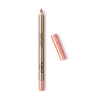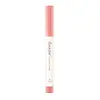What's inside
What's inside
 Key Ingredients
Key Ingredients

 Benefits
Benefits

No benefits
 Concerns
Concerns

 Ingredients Side-by-side
Ingredients Side-by-side

Isododecane
EmollientMica
Cosmetic ColorantSynthetic Wax
AbrasivePolybutene
Trimethylsiloxysilicate
EmollientSucrose Tetrastearate Triacetate
EmollientIsoamyl Laurate
EmollientSilica
AbrasiveHydrogenated Jojoba Oil
AbrasiveCetearyl Behenate
EmollientSynthetic Fluorphlogopite
Pentaerythrityl Tetra-Di-T-Butyl Hydroxyhydrocinnamate
AntioxidantCI 77891
Cosmetic ColorantCI 15850
Cosmetic ColorantCI 77491
Cosmetic ColorantCI 45410
Cosmetic ColorantCI 19140
Cosmetic ColorantCI 77742
Cosmetic ColorantCI 15985
Cosmetic ColorantCI 42090
Cosmetic ColorantIsododecane, Mica, Synthetic Wax, Polybutene, Trimethylsiloxysilicate, Sucrose Tetrastearate Triacetate, Isoamyl Laurate, Silica, Hydrogenated Jojoba Oil, Cetearyl Behenate, Synthetic Fluorphlogopite, Pentaerythrityl Tetra-Di-T-Butyl Hydroxyhydrocinnamate, CI 77891, CI 15850, CI 77491, CI 45410, CI 19140, CI 77742, CI 15985, CI 42090
Isononyl Isononanoate
EmollientHydrogenated Polydecene
EmollientButylene Glycol Dicaprylate/Dicaprate
EmollientSilica
AbrasiveCeresin
Emulsion StabilisingVinyl Dimethicone/Methicone Silsesquioxane Crosspolymer
Synthetic Wax
AbrasiveDimethicone
EmollientPolyglyceryl-2 Triisostearate
EmulsifyingSynthetic Fluorphlogopite
Sorbitan Sesquioleate
EmulsifyingDimethicone Crosspolymer
Emulsion StabilisingPolyhydroxystearic Acid
EmulsifyingTocopheryl Acetate
AntioxidantPhenoxyethanol
PreservativePentaerythrityl Tetra-Di-T-Butyl Hydroxyhydrocinnamate
AntioxidantRosa Canina Fruit Oil
EmollientPrunus Armeniaca Kernel Oil
MaskingTitanium Dioxide
Cosmetic ColorantCI 77491
Cosmetic ColorantCI 77492
Cosmetic ColorantCI 15850
Cosmetic ColorantIsononyl Isononanoate, Hydrogenated Polydecene, Butylene Glycol Dicaprylate/Dicaprate, Silica, Ceresin, Vinyl Dimethicone/Methicone Silsesquioxane Crosspolymer, Synthetic Wax, Dimethicone, Polyglyceryl-2 Triisostearate, Synthetic Fluorphlogopite, Sorbitan Sesquioleate, Dimethicone Crosspolymer, Polyhydroxystearic Acid, Tocopheryl Acetate, Phenoxyethanol, Pentaerythrityl Tetra-Di-T-Butyl Hydroxyhydrocinnamate, Rosa Canina Fruit Oil, Prunus Armeniaca Kernel Oil, Titanium Dioxide, CI 77491, CI 77492, CI 15850
Ingredients Explained
These ingredients are found in both products.
Ingredients higher up in an ingredient list are typically present in a larger amount.
Ci 15850 is the pigment color red. It is an azo dye and created synthetically.
Azo dyes need to be thoroughly purified before use. This allows them to be more stable and longer-lasting.
This ingredient is common in foundations, lipsticks, and blushes. This color is described as brown/orangey red.
It has many secondary names such as Red 6 and Red 7. According to a manufacturer, Red 6 usually contains aluminum.
Learn more about CI 15850Ci 77491 is also hydrated iron III oxide. It's sole purpose is to give a red/pink hue to products.
Iron III oxides are classified as inorganic chemicals for coloring.
Synthetically created Ci 77491 is considered safer than those naturally found. This is because the synthetically created version may contain less impurities. Iron oxides are generally non-toxic and non-allergenic.
Learn more about CI 77491Pentaerythrityl Tetra-Di-T-Butyl Hydroxyhydrocinnamate (long name, huh?) is a synthetic antioxidant.
It is used to help stabilize other antioxidants or prevent the color from changing in a product.
As an antioxidant, it helps fight free-radical molecules. Free-radical molecules are capable of damaging our cells and other genetic material. Thus, antioxidants may reduce the signs of aging.
This ingredient is oil-soluble.
Learn more about Pentaerythrityl Tetra-Di-T-Butyl HydroxyhydrocinnamateSilica, also known as silicon dioxide, is a naturally occurring mineral. It is used as a fine, spherical, and porous powder in cosmetics.
Though it has exfoliant properties, the function of silica varies depending on the product.
The unique structure of silica enhances the spreadability and adds smoothness, making it a great texture enhancer.
It is also used as an active carrier, emulsifier, and mattifier due to its ability to absorb excess oil.
In some products, tiny microneedles called spicules are made from silica or hydrolyzed sponge. When you rub them in, they lightly polish away dead skin layers and enhance the penetration of active ingredients.
Learn more about SilicaSynthetic Fluorphlogopite is the synthethic version of mica. It consists of fluorine, aluminum and silicate.
Synthetic Fluorphlogopite is used to add volume to products.
It is considered non-irritating on the skin.
Learn more about Synthetic FluorphlogopiteSynthetic Wax is created from fossil fuels such as natural gas. It is used to enhance texture, adjust pH, and as an occlusive.
It may also be used as an abrasive ingredient to exfoliate the skin.
Synthetic Wax may not be fungal acne safe.
Learn more about Synthetic Wax